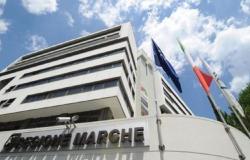
PRATO – Work has begun on the construction of the Textile Hub in Prato. The project involves the construction, in via di Baciacavallo, of an automatic selection plant for post- and pre-consumer textile waste, with a capacity of approximately 33,000 tons per year, to guarantee its subsequent reuse and recycling. The plant, for which excavation of the foundations began today in the presence of the mayor of Prato, Matteo Biffoniof the president of Alia Multiutility Lorenzo Perraof the vice president Nicola Ciolini and the CEO Alberto Iracewill come into operation in the first half of 2026. It will be the only plant of its kind in Italy serving an entire production district, such as the Prato textile one, and the only one to use artificial intelligence and highly advanced infrared technology to carry out the sorting by color and composition of the various textile materials.
Once the authorization process and the single regional authorization for construction and operation were concluded, the area of via Baciacavallo on which the Hub will be built was purchased by Alia and entrusted to the construction company Polistrade, which won the tender and it will take care of the construction of the civil structures and the compensation works envisaged. For the moment, all existing disused buildings have been demolished and preparatory work has been carried out for the actual start of the construction site, with the first excavations of the foundations. The works include the initial redevelopment of the area subject to intervention, and the implementation of building and civil works that will lead to the construction of the new buildings. Subsequently, the fence, the gates, the sewerage system, the car parks, the roads and, finally, the compensation works will be built. The works will end with the construction of the fire-fighting, thermo-hydraulic and air treatment systems by the end of 2025. At the beginning of 2025, the construction of the automatic selection system which uses artificial intelligence (technology called Fibersort by Belgian company Valvan) and of the mechanical recycling line, consisting of a pre-fraying phase, in order to make the selection plant operational as early as the first quarter of 2026, in full compliance with the Pnrr deadlines, indicated at 30 June 2026.
At full capacity the Hub will process two types of flows: 20,000 tonnes of material per year (more or less corresponding to the entire regional requirement) deriving from the post-consumption circuit and 13,000 tonnes per year deriving from the pre-consumption circuit ( approximately 50% of this type of waste, typically textile production and processing waste, will derive from the activities of the Prato textile district). It is estimated that, as regards post-consumption, 60% of the garments (12,000 tonnes), after specific sanitisation, will be sent to companies already present in the Prato area and specialized in this market sector. The remaining 40%, made up of non-reusable items of clothing, once the accessory components such as zips, buckles, buttons have been eliminated, will be sent to the automatic line which will select the waste by fiber and color and can then be sent to the pre-fraying line to facilitate, if necessary, subsequent mechanical recycling. In the same way, the flows deriving from the pre-consumption circuit, which at this moment are mainly sent to landfill or to thermal destruction due to the difficulty of being selected manually, will be sent to the automatic selection line, possibly treated in the pre-fraying line for recovery easily reusable fibers and then sent to specialized recycling plants, based on the characteristics of the materials to be processed.
“The textile industry is considered the fourth most polluting industry in the world and the fifth for greenhouse gas emissions,” said Perra. “The action plan for the circular economy has included an action strategy, the Eu Textile Strategy. , to develop innovation, support new business models and address and reduce environmental impacts throughout the textile supply chain, seeking to increase the sustainability, reusability and recyclability of clothing. The Textile Hub project fully responds to these objectives and, precisely due to the validity of the technological proposal, it obtained second place in the ranking among those presented to access the Pnrr funds. It represents an opportunity for growth and a tool for creating value for the entire Prato district. It will also be the first plant in Italy to use an automatic system for selection based on fiber quality and color.”
The project, with a total cost of 29.5 million euros (of which 23.5 for the systems and complementary works, 2 for the purchase of land and 4 for the movement of wells and water and gas pipes) in part financed with Pnrr funds, involves the construction of a recovery plant for non-hazardous special waste, deriving from waste of textile origin and used clothing, consisting of a main shed with a surface area of approximately 6,400 square metres, with a height of 10 metres, within which the storage of incoming waste and intermediate waste and the automatic and semi-automatic selection lines of textile waste will be positioned, as well as the presses for the volumetric reduction of the products. A second shed, of approximately 2,000 square metres, will house a fraying line, but also part of the intermediate waste storage and, on the first floor, offices, changing rooms and toilets. A shed of approximately 1,300 square meters will be attached to this building for the storage of waste produced by processing. The external spaces, for a total of approximately 14,000 square metres, will be divided into an area for weighing incoming vehicles, handling spaces, roads and car parks and tall trees suitable for shielding the entire system will be planted.
The facility will automatically screen incoming waste, using artificial intelligence (AI) models to predict fiber concentration based on near-infrared spectroscopy (NIRS) scans, which include pure fibers and fiber blends; this technology is one of the most innovative on the European market, therefore capable of recognizing the various materials that make up each fabric and their colour. Once selected, the materials will be sanitized, stripped of any components that may be critical for subsequent processing and sent to specific machinery capable of making the fabric fibers easily reusable in the subsequent industrial processes for which they will be destined. The material leaving the plant will be sent to companies already present in the area and partners of the Hub for effective recycling operations (textile district, production of acoustic panels and furniture, production of asphalt, chemical recycling).
“The Textile Hub was born from an extended, inclusive and distributed concept across the territory, to make Prato even more of a reference model of circular economy for the reuse of used clothing and textile processing waste, – added Ciolini – the district Prato, thanks to the Textile Hub, will be able to offer the Italian manufacturing system valid support to overcome the current difficulties in supplying raw materials intended for production. This lack will be compensated by the secondary raw materials resulting from effective and efficient recycling of exploitable textile fibres. A circuit that will be certifiable in all respects and that will contribute to returning added value to productions made with recycled materials, in the sign, already outlined at European level, of greater attention to environmental sustainability, recycling and reuse”.




